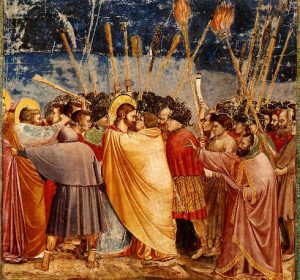by Lena Einhorn
(New York: Yucca Publishing, 2016; 227+11 pages)
Review by Hermann Detering
translated from the German by René Salm
[For a 2012 review of Einhorn’s work on this site, see here.]
Lena Einhorn has distinguished herself in Sweden as a documentary filmmaker. She is known in Germany mostly for her Holocaust book, Ninas Reise (“Nina’s Journey: How my Mother Escaped from the Warsaw Ghetto”). Over the last decade, the focus of her interest has moved to early Christianity. In 2007 the English edition of her book appeared, The Jesus Mystery: astonishing Clues to the True Identities of Jesus and Paul (Guilford, Conn.: Lyons Press; German edition 2007, Das Rätsel von Damaskus: Waren Jesus und Paulus ein und dieselbe Person? Heyne Verlag). Since 2010 Einhorn has annually presented papers at the SBL conventions, in which she has elaborated a new hypothesis regarding Christian origins. A synthesis of her bible-critical work now appears in her 2016 book considered here, A Shift in Time: How Historical Documents Reveal the Surprising Truth About Jesus (New York: Yucca Publishing).

Lena Einhorn
(a) the paucity of extra-Christian attestation for the events reported in the gospels, particularly those relating to the figure of Jesus; and
(b) signs of a “militant” Jesus—clearly evident in certain passages of the gospels—that do not conform (or conform only with difficulty) to the peace-loving savior known to Christian tradition.
As regards (the lack of) extra-Christian attestation, I have already treated this in extenso in my book, Falsche Zeugen: Ausserchristliche Jesuszeugnisse auf dem Prüfstand (“False Witnesses: Extra-Christian Witnesses to Jesus on Trial,” Aschaffenburg: Alibri 2011).
Many scholars conveniently suggest that Jesus was simply too minor a figure to have engaged the attention of contemporary writers. Like Einhorn, however, I have argued that this view is untenable given the extraordinary impact of Jesus’ presence on his contemporaries—an impact that the evangelists highlight in many passages. Einhorn observes that Jesus’ large following and his spectacular disputes with both the Jewish and the Roman authorities would not have escaped the notice of contemporary chroniclers.
Point (b) above is confirmed through careful examination of the New Testament witness—particularly the Gospels of Luke and John. For example, Einhorn notes circumstances accompanying the arrest of Jesus on the Mount of Olives. According to the Fourth Evangelist, we are dealing with a Roman cohort (Gk. speira) of between 600 and 1,000 soldiers (Jn 18:3, 12), while Luke (22:47–54) describes disturbances of riotous proportions.

The Arrest of Jesus
by Giotto (1266–1337 CE)
When the above-mentioned points (a) and (b)—which are premises of the book—are considered together with a careful reading of Josephus, then certain consequences follow that lead Einhorn to a solution of the dual mystery: Yes, there was an historical Jesus. That he was not mentioned by contemporaries owes to the facts that—contrary to the depictions of the evangelists—he lived later and, furthermore, he is to be identified with one of the anti-Roman freedom fighters from the 50s CE described by Josephus. Einhorn supports the latter astonishing proposition with a series of notable anachronisms. Above all, she draws parallels that—in her view—cement relationships between events and persons in the gospels on the one hand, and in Josephus on the other. The life and fate of several messianic pretenders chronicled by Josephus—including Theudas (44–46 CE), the so-called “Egyptian” (52–59 CE), Menahem the son (grandson?) of Judas the Galilean (66 CE), and Simon bar Giora (66–76 CE)—these personages, in her view, all betray striking resemblances to figures mentioned in the gospels.
Taking Josephus’ “Egyptian prophet” (Ant. 20.169–72; War 2.261–63) as an example, Einhorn points out that:
 (a) like Jesus, he was associated with the wilderness (eremia)
(a) like Jesus, he was associated with the wilderness (eremia)
(b) like Jesus, he lived in Egypt
(c) like Jesus, he wanted to tear down the walls of Jerusalem
(d) like Jesus, he was a messianic leader with a large following
(e) like Jesus, he represented a threat to both Jewish and Roman authorities
(f) like Jesus, he was betrayed
(g) like Jesus, he was defeated on the Mount of Olives
Einhorn also detects seminal parallels between Theudas and John the Baptist: both were spiritual leaders, both were active about the Jordan River, and both were decapitated by the Jewish religious establishment—their deaths, however, having taken place fifteen years apart, Theudas dying in the time of the Judean procurator Fadus. Now, Einhorn considers it most unlikely that John was executed by Herod Antipas, since the latter was ruler of Galilee and Peraea but not of Judea, where John was active.
Einhorn claims further meaningful parallels, for example between the messianic pretender Menahem and Simon Peter, as also between the protomartyr Stephen (Acts 6–7) and a Stephen in Josephus (Ant. 20.113–17; War 2.228–31; Einhorn pp. 63 f).
Einhorn does not deny that, besides the parallels, significant differences between the two Stephens exist. The same can be said in comparing Jesus with the Egyptian, where differences are obvious: Jesus was captured on the Mount of Olives and then crucified, while the Egyptian escaped capture; in one account a fight is lacking, in the other a crucifixion.
In Einhorn’s view, however, both the parallels and the differences can be explained. She maintains that the evangelists deliberately adopted a time shift. For her, the gospels, Acts, and Josephus all report on the same events—but the Christian authors have intentionally backdated those events by 15–20 years. Einhorn gives two principal reasons why they did so:
1. competing traditions were in this way neutralized (thus protecting incipient Christianity);
2. the militant side of the Christian messiah was thus hidden.
In these ways Einhorn views the New Testament gospels and Acts as containing both a surface account and a subtext. The surface account describes events and figures from around the year 30 CE. The cryptic subtext, however, deals with the rebellion against Rome and against Jewish institutional authority. In Einhorn’s view, the true story was subsequently hidden in order to disguise Christianity’s beginnings as a conspirational and rebellious movement against Rome.
Next →


The value of Einhorn’s book is not her Egyptian theory but her use of a time-shift argument for the gospel story. Unfortunately, she went the wrong way with her time-shift. She went forward from the time of Pilate rather than going backwards to earlier than Pilate. If a time-shift is to be considered as an approach to the gospel story – then going back to earlier Hasmonean history cannot be ruled out. The benefit of Hasmonean history for the gospel crucifixion story is that it does relate a Roman execution of a King of the Jews. That historical event, attested by Josephus, Plutarch and Cassius Dio, is an event that would have had a far more profound relevance for the Jewish people than any insurrection by an unnamed, unevidenced, Josephus figure of an Egyptian – the manner of whose death is not even mentioned by Josephus.
Or personally, I’d go both ways. To me, the New Testament looks like a complete mashup of stories all the way from the time of Moses,through to say 140 AD or so.
[I have abridged the following comment, which as received was much longer.–RS]
… I agree with Einhorn that the Jesus of the Gospels existed as a historical person, and that the origins of Christianity are darkened by a chronology problem. This forged chronology is the main reason for Jesus’ continuing elusiveness…
While Einhorn concludes that the crucial events reported in the Gospels have been antedated by approximately 20 years, I have good arguments to advance that they have been antedated by approximately 40 years. The militant Jesus who is right beneath the surface of the Gospel texts was not one of the many messiah pretenders of the decades before the war, but a Galilean priest and leader of the great rebellion. The apocalyptic texts in the New Testament (Synoptic Apocalypse and Revelation, especially chapter 11) reveal the real chronology, although in a veiled way. So while there are quite some similarities between Einhorn’s research and mine, I believe she walked only half the road (20 years) while I did the whole stretch (40 years)…
… The antedating of the Gospels has been introduced for political reasons and was inspired by anxiety. Jesus’ spectacular survival of his crucifixion had to be written away from the war, otherwise this story was doomed to be ruthlessly suppressed in the hostile Roman world. Mark wrote his Gospel soon after the events, in the years when Josephus wrote his Jewish War…
My research has been published… in English as an Amazon Kindle e-book in 2015 under the title ‘A Chronological Revision of the Origins of Christianity’…
I end this comment with a little ‘Who’s who in first century CE Palestine’.
• Jesus of the Gospels = Jesus son of Saphat in Josephus (Life and War)
• Joseph of Arimathea in the Gospels = Joseph bar Matthea, the great historian
• Paul of the New Testament = combination of the historical Paul, the trailblazer of the future messiah, in the 50’s and 60’s of the 1st century CE, and the later, 2nd century CE forgery of Paul into a follower of Jesus the messiah.